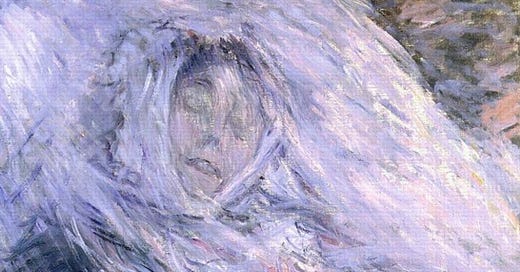Camille on her deathbed, by Claude Monet (1879)
Shortly after her death, Monet painted this beautiful and yet haunting image of his first wife Camille Doncioux. It’s one of his most unusual and heartbreaking works.
Without Camille, Monet would have never become a professional artist, as she had been the model who launched his career when she posed as the mysterious “lady in a green coat”. When it was accepted to the Salon it caused a sensation, leading Zola to declare Monet the “only virile painter” in France. She died of pelvic cancer, possibly related to having suffered through several botched abortions.
If you’re wondering what it must have been like for Monet to paint his beloved so shortly after she passed away, he actually left us a heartbreaking letter where he describes his morbid fascination with how the light played on her shroud. In the letter he describes describes how he feels almost ashamed that he cannot stop painting her, even in death.
“I caught myself, as I stared down at her tragic face, casually wondering about the pattern, about the gradual loss of Colour that death had brought to her lifeless features. That’s how low I had sunk. It’s a natural reflex to reproduce the last image of the one who has just left us forever. But before the idea came to paint the features I was so deeply attached to, my natural instinct was to react to color first, and my reflexes were leading me, in spite of myself, to subconscious rote behavior that swallows up my day-to-day life. Like a beast grinding at the mill.”
To me, this painting of Camille contains the essence of Impressionism. Life, in its abstract form, serves to reproduce reflection Or, to put it in Monet’s terms, it “swallows up” the particular reality of life and subsumes it into color and light. No wonder 19th century critics were horrified.
To me, this painting reveals the aesthetic project of Impressionism, what one might call its beautiful, tragic, morbid core. For art to be “true”, the form had to play second fiddle to the subjective appearance of light and color. Instead of just painting Camille as he would have liked to remember her, Monet depicted the impression left on him by her deathbed. It is so much more powerful for it.
That’s why Monet characterizes himself as a “beast grinding at the mill. The best tribute to Camille is to keep painting her, not as an idealized portrait, but exactly how she appeared to him, effervescent, absent, her deathly linen like a canvas for the reflection of light, life and death.
The painting works because it’s not just about Monet’s private grief. Rather, it serves as an example of how far he (and in her life, Camille) were willing to go to relentlessly pursue their aesthetic project of depicting truth in art. This painting contains the full power of Impressionism. To me at least…
Thank you for reading my newsletter. I’d you’d like to unlock a weekly podcast as well as my reading recommendations, please consider becoming a paying subscriber. Simply click the button below.





The peacefulness of death, he paints her expression as if she is lifted, floating, the shroud like wings around her face.